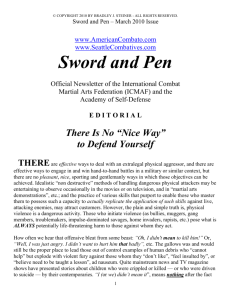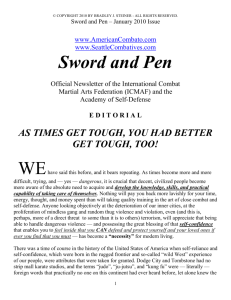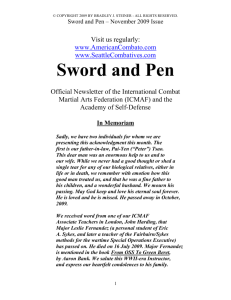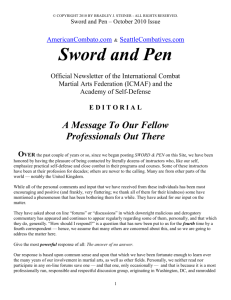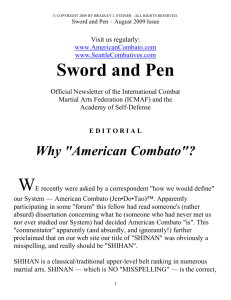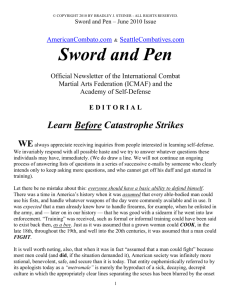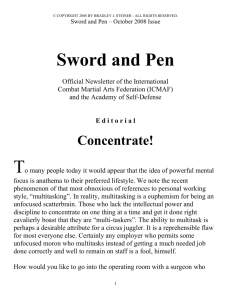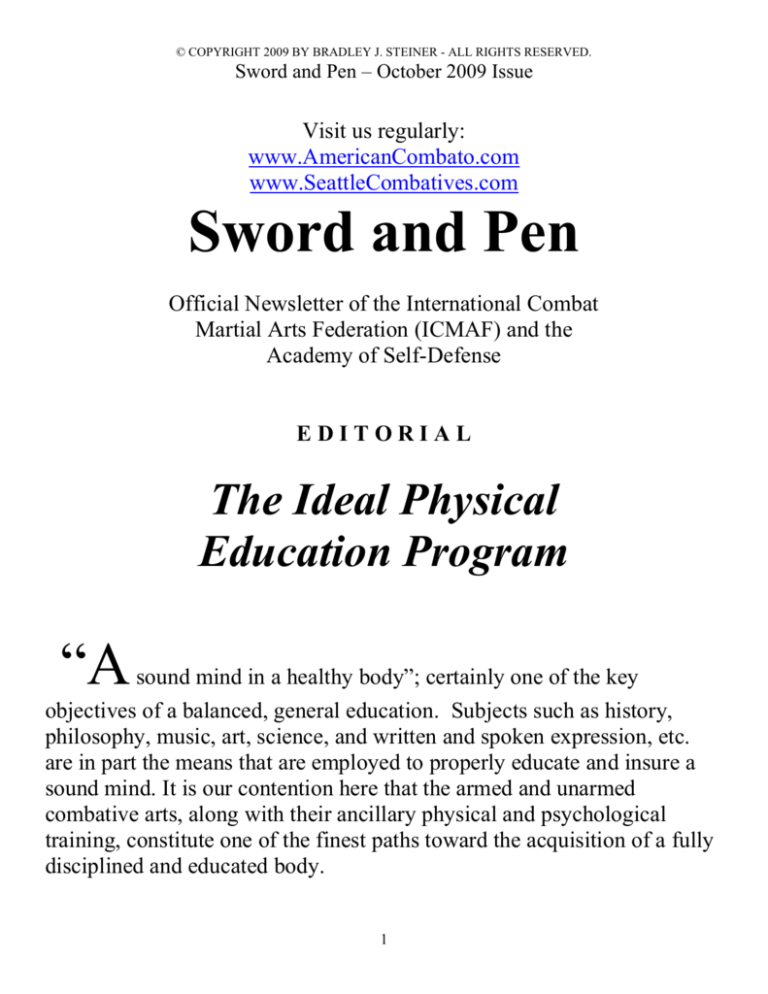
© COPYRIGHT 2009 BY BRADLEY J. STEINER - ALL RIGHTS RESERVED.
Sword and Pen – October 2009 Issue
Visit us regularly:
www.AmericanCombato.com
www.SeattleCombatives.com
Sword and Pen
Official Newsletter of the International Combat
Martial Arts Federation (ICMAF) and the
Academy of Self-Defense
EDITORIAL
The Ideal Physical
Education Program
―A
sound mind in a healthy body‖; certainly one of the key
objectives of a balanced, general education. Subjects such as history,
philosophy, music, art, science, and written and spoken expression, etc.
are in part the means that are employed to properly educate and insure a
sound mind. It is our contention here that the armed and unarmed
combative arts, along with their ancillary physical and psychological
training, constitute one of the finest paths toward the acquisition of a fully
disciplined and educated body.
1
© COPYRIGHT 2009 BY BRADLEY J. STEINER - ALL RIGHTS RESERVED.
Sword and Pen – October 2009 Issue
It is possible that things have changed since we were a student. However,
if the so-called ―physical education‖ curriculum that we were subjected to
is anything like that which is being foisted upon students today, then the
system stinks.
The ―physical education‖ (what a ridiculous designation for it!) that we
experienced in school amounted to nothing more than carelessly
conducted sports, or (even more carelessly conducted) exercises. The
teachers were either indifferent or incompetent (often both), and just like
the miserable excuses for those who were licensed to teach the academic
subjects, the P.E. teachers simply focused on the few fellows who were
natural athletes, and neglected anything resembling an effort to instruct the
rest of us in proper physical education.
All is never lost, however; even when the school system wreaks of
asininity, neglect, incompetence, and irrelevance. Self-education remains
open to all who desire it and who have the self-discipline to work to
achieve it. This of course applies in the physical as well as in the
intellectual sphere.
We have noticed, with considerable pleasure, that a few of the better
institutions of higher education (in which, thankfully, some education
actually does take place), like St. John’s College in Annapolis, Maryland,
and in Santa Fe New Mexico, now offer serious, ongoing programs in
martial arts. A step in the right direction, in our opinion. But not enough.
Such schools as St. John’s recognize the value of physical education, and
they take it seriously. However, we personally believe that a solid
curriculum in no-nonsense combatives — with and without weapons — is
the ideal ticket; and we’ll tell you why. We also will say this: Whether you
are presently in school or not, and regardless of what foolishness the
2
© COPYRIGHT 2009 BY BRADLEY J. STEINER - ALL RIGHTS RESERVED.
Sword and Pen – October 2009 Issue
schooling of your earlier years subjected you to, in lieu of a sound
educational program, there is nothing — save your indolence — standing
in the way of your making up for that which the school system failed to
provide; intellectually or physically.
Sports and games are recreational. There is nothing wrong with recreation,
and certainly we all should enjoy and appreciate the value of recreation in
our lives. But education entails and involves a great deal more than
recreation. Education is disciplined growth and expansion of the
individual’s capacities — physically and intellectually.
What follows is a list of ten reasons why we believe strongly that an
ongoing program of training in modern combatives is an ideal form of
physical education:
1. Learning and practice of the skills involved develops the whole
physique and produces balanced cultivation of all desirable physical
attributes.
If the practice of the techniques per se does not fully develop a desirable
attribute, then working on the ancillary training activities will. Take
strength for example. Practice of close combat and self-defense skills does
contribute somewhat to an individual’s increased strength, but it is weight
training (the key supplementary activity for the student of this art) that
builds high levels of strength. Other supplementary activities, such as rope
skipping or jogging, training in conditioning the natural weapons, etc.
rounds out the full developmental benefits of combatives training, when
properly taught and undertaken.
2. The ancillary activities that go with modern combatives training are all
3
© COPYRIGHT 2009 BY BRADLEY J. STEINER - ALL RIGHTS RESERVED.
Sword and Pen – October 2009 Issue
valuable and important health, strength, and condition builders in their
own right.
3. The proper study of this art teaches a relevant, useful skill. The
acquisition of this skill brings with it great benefits, mentally and
physically, for the individual’s entire life. His intellectual education
enables him to form convictions and to establish the values by which the
student will live his life. Combatives training (ie physical education)
instills the knowledge, skill, and courage that enables the student to stand
up for his convictions, and to defend those values, should they ever be
threatened.
4. Like any proper educational endeavor, the study of combatives
emphasizes the INDIVIDUAL, and not the ―group‖. Unlike pointless
competition or merely enjoyable recreation, individual development of
close combat and self-defense abilities refines and bolsters the individual
as an individual, teaching him to stand alone, if necessary, and to defend
himself.
5. Training in combatives is adjustable to the needs, interests, and inherent
abilities of anyone, regardless of his possession or lack of athletic acumen.
Just as the study of liberal arts is for everyone, regardless of IQ, career
path that may be chosen, or natural talents and interests, so combatives
training is for — and benefits — everyone who has the opportunity to
study the subject properly.
6. While most unpopular today, we nevertheless maintain that the
development of MANLY VIRTUES (self-confidence, self-reliance, inner
toughness, strength, resolve, and intestinal fortitude, etc.) is highly
desirable and all but indispensable in the total education of any man.
4
© COPYRIGHT 2009 BY BRADLEY J. STEINER - ALL RIGHTS RESERVED.
Sword and Pen – October 2009 Issue
There are few vehicles as effective in cultivating the manly virtues as a
serious, professionally rendered study of close combat and self-defense.
7. There is a great deal of fascinating history and culture to be studied in
the course of learning close combat and self-defense. This is, after all, a
MARTIAL ART, and as is the case with the study of any art, there is
much more to the endeavor than mere technique.
8. The Art and its ancillary activities may be practiced at home, with or
without a partner, with limited or no equipment, and over the individual’s
entire lifetime.
Obviously, it is desirable to have equipment and facilities set up for
training. However, there is always a way to train, practice, and improve
oneself, regardless of how little space or equipment is available, once one
has had a thorough grounding in the fundamentals. Like the furtherance of
intellectual education via reading (which is a lifetime pursuit and requires
no special facilities), the furtherance of one’s physical education — on
one’s own anywhere, anyplace — is necessary; and it is easily possible
using the knowledge gained in a good course of instruction in close
combat and self-defense.
9. The study encourages independence, self-reliance, courage, and resolve
— and, just as proper intellectual education enables one to succeed in
ANY lifetime pursuit by providing the intellectual skills and tools that are
required to think , and to make informed choices, so does this excellent
physical education enable one to succeed in ANY undertaking by
providing the physical confidence, ―guts‖, strength, and tenacity that
forms and nurtures the requisite character demanded for real world success
in anything.
5
© COPYRIGHT 2009 BY BRADLEY J. STEINER - ALL RIGHTS RESERVED.
Sword and Pen – October 2009 Issue
10. The study teaches the student an enormous amount about the human
body, about psychology, about the law regarding self-defense, and about
the martial virtues of warriors throughout the ages. It cultivates safe and
lifesaving habits with modern weapons, and when properly taught
instructs the individual in the moral and proper use of FORCE. It produces
a fully educated GENTLEMAN WARRIOR.
Whether the reader agrees with us or not, we feel that we’ve at least raised
an interesting point for him to reflect upon. The body is no less important
than the mind; and since each requires education in order to live a full,
rich, and balanced life, we suggest that serious consideration of what,
precisely, physical — no less than intellectual — education ought properly
to consist of is important.
Bradley J. Steiner
Proper Protective Distancing
Correct distancing is a matter that is always addressed in the
classical/traditional martial arts. Unfortunately, actual practice of this
aspect of dealing with an adversary comes — in the classical/traditional
approaches — from sparring and from competitive matches; both
unrelated to close combat and/or the requirements of actual self-defense
encounters. When you train to ―square off‖ with an opponent, to ―get set‖,
to ―ready yourself in a stance‖, etc., and to anticipate that your adversary
will either strike or grapple in a conventional (or at least in a restricted and
regulated) manner you are not duplicating the kind of DISTANCING
TRAINING that the real world requires, should you need to actually
defend yourself.
6
© COPYRIGHT 2009 BY BRADLEY J. STEINER - ALL RIGHTS RESERVED.
Sword and Pen – October 2009 Issue
First of all, forget about ―fighting stances‖. These are for agreed-upon
matches (or mutual combat — neither one of which is related to that
which a self-defense or close combat practitioner concerns himself with).
In the real world you will either be AWARE of an attacker’s approach
prior to his onslaught, or you will not be aware. If you aware, go to a
ready position and if/when the first indication of aggression manifests,
PREEMPT! If you are not aware, you’ll simply be reacting via the best
counterattacking actions of which you are capable. (There is a third
possibility for military and intelligence people: You may be
ATTACKING THE OTHER GUY. If this is the case, then take him by
surprise — if at all possible from behind — and finish the job. Do not
walk up in front of him and get into some ridiculous stance!).
In any case, you will advance your development and readiness to deal with
real violence from a troublemaker who makes his approach apparent, by
applying the following INVIOLATE RULE:
Whenever you face anyone who you do not know, personally, off angle
yourself (into a ―relaxed-ready‖ position), and maintain a distance from
that person that is no closer than OUTSIDE ARM’S LENGTH.
What the assumption of that distance does is insure that, when and if this
unknown individual initiates an attack, he will need to step forward toward
you in order to reach you. This make a genuine ―surprise attack‖ from him
(assuming that you are in an ALERT MENTAL STATE) virtually
impossible. The most skilled individual in the world must still be able to
reach you, before he can harm you. And the fact that you have distanced
yourself outside the range of his reach insures that his FORWARD STEP
will telegraph his intention.
7
© COPYRIGHT 2009 BY BRADLEY J. STEINER - ALL RIGHTS RESERVED.
Sword and Pen – October 2009 Issue
Question: ―Suppose the individual merely intends to step closer to me, and
nothing more? Might I not be making a tragic error of judgment if I
attacked him as he moved?‖
Answer: Indeed, you would be making a terrible error by attacking a nonaggressive individual. However, doing so is easily avoided, and you ought
never have such a problem. Just STEP BACK if the step toward you is
apparently non aggressive. REESTABLISH the outside-arm’s-length
distance. Politely say, ―Sir, please step back,‖ if you wish, as you yourself
move. That gesture and statement is neither provocative nor offensive, and
will do all that is necessary without incurring any possibility of
―misapplied aggression‖. A person whose intention is not aggression will
keep his distance.
By maintaining this out-of-reach distance you will enjoy another
advantage, should the individual whom you face decide to attack you. His
attack and your preemptive reaction will bring about a COLLISION
EFFECT, and add whatever weight and momentum your attacker
generates toward you, to whatever power and momentum your preemptive
action directs toward him.
Violent offenders, generally speaking, will not attempt to attack if they do
not feel that their onslaught will be effective, if they feel that they will be
hurt, and if they have no assurance that they will be able to get away
before the police arrive. Since the impression conveyed by a person who
remains steadfastly distanced, alert, and not readily approachable is NOT
that this person is susceptible to a surprise attack, assuming a proper offangled ready position and holding to the right distance might discourage
some attacks, to begin with. This of course is what we would most hope
8
© COPYRIGHT 2009 BY BRADLEY J. STEINER - ALL RIGHTS RESERVED.
Sword and Pen – October 2009 Issue
for, but we cannot expect it in all cases.
Correct understanding of the principle, and unwavering use of the strategy
of employing PROPER DISTANCING will go a long way toward
assisting you in both avoidance and in being prepared for preemption,
should avoidance be impossible.
One final thing: Whenever you are approached by two or more individuals
who you do not know personally, STEP TO THE OUTSIDE OF THE
PAIR/GROUP and assume your relaxed ready position facing the closest
person. Keep your distance relative to him, outside arm’s reach.
Yelling
We have written a rather extensive article on this subject, which appears
on our other site: www.seattlecombatives.com. We would urge you to read
it, heed it, and not forget its message. Coming to an understanding of how
yelling positively affects a fighting man’s effectiveness, and the
CORRECT — as opposed to the ―popularly taught‖ — relation between
yelling and ―kiai‖ should be understood by all serious students of close
combat and self-defense.
For right now we wish simply to make the point that a piercing shout can
be an enormously effective aid in a self-defense emergency. Like the
physical action that it is intended to bolster, augment, and assist in
shocking the enemy into a state of momentary bewilderment, the yell that
you employ in a confrontation should seem to come out of nowhere.
We have observed ―experts‖ demonstrate defense skills by facing a partner
who is playing the role of the attacker, and then shout — as they assume a
9
© COPYRIGHT 2009 BY BRADLEY J. STEINER - ALL RIGHTS RESERVED.
Sword and Pen – October 2009 Issue
fighting stance. Foolish. Not the way to use yells in close combat.
The purpose of yelling is not to WARN your enemy, and to ANNOUNCE
your preparedness to do battle.
Ideally, a bloodcurdling, sharp, explosive yell should coincide with a
surprise attack that immediately inflicts serious injury. When a
troublemaker, bully, tough guy, or other variant of PUNK anticipates
―easy pickings‖ and without warning fingers are plunged into his eyes as
he hears a piercing scream (or his leg is broken, or his throat is crushed, or
his sternum is punched, etc.) then the overwhelming shock — mental and
physical — will almost certainly render him utterly helpless to prevent
whatever followup, finishing actions you may wish to employ.
Use yelling that way.
When you preempt, YELL. The proper way to yell is by shouting in a
loud, barking shriek. A brief shriek. The kind of sudden screaming yell
that, accompanied by as grotesque a grimace and facial snarl as you can
muster, almost ―hits‖ your enemy’s consciousness like a physical blow.
This should be done AS YOU TAKE HIM BY SURPRISE AND
ATTACK WITH WHATEVER ACTION YOU ELECT TO EMPLOY.
The combined physical and mental shock of this dual assault will cause
anyone to freeze momentarily. Now get busy with followup. There is more
to understand about this matter of shouting in close combat, and so we
refer you to www.seattlecombatives.com. What we’ve just given you is an
encapsulated lesson in how to do it correctly.
And by the way, this is not synonymous with ―kiai‖.
10
© COPYRIGHT 2009 BY BRADLEY J. STEINER - ALL RIGHTS RESERVED.
Sword and Pen – October 2009 Issue
Bare Knuckle Boxing
And Punching In Hand-To-Hand Combat
Using the clenched fist either as a primary weapon or as a natural weapon
with which to attack the facial/head area is WRONG for close combat and
self-defense. Those who, correctly noting the deficiencies in the sport of
Western boxing insofar as self-defense is concerned, have gravitated to the
older (rougher and tougher) ―bare knuckle boxing‖, thinking that this will
give them a ―boxing system for the street‖ are misinformed.
The old bare knuckle boxers were tough as nails, and yes, their method of
boxing was superior for self-defense to the modern boxing we are
accustomed to seeing today. However, the fact that bare knuckle boxing is
superior to modern boxing for personal combat by no means demonstrates
that bare knuckle boxing is a viable method of combat training, per se.
Using a garden hose to attempt to put out a house fire makes more sense
than relying on filling, refilling, and repeatedly tossing buckets of water
on the fire. BUT NEITHER APPROACH MAKES MUCH REAL SENSE
AS A MEANS OF BATTLING A HOUSE FIRE.
Bare knuckle boxers use their clenched fists for normal-fist punching. This
is a serious mistake for self-defense or hand-to-hand combat. It is as much
a mistake for the bare knuckle boxer as it is for the karate student, since
other much more effective and reliable natural weapon hand blows have
been proven beyond question to be infinitely better choices for close
combat. (We must state here, for the overly sensitive, that we are in no
shape, manner, or form deriding bare knuckle boxing, per se. We are
speaking only of how this sport stacks up FOR REAL COMBAT.)
To be a true fist fighter who stands any reasonable chance of stopping a
11
© COPYRIGHT 2009 BY BRADLEY J. STEINER - ALL RIGHTS RESERVED.
Sword and Pen – October 2009 Issue
dangerous physical assailant, you must be REAL GOOD, an expert, or at
least a strong, fit, boxer-in-training with conditioned fists.
Our advice: Waste no time training in bare knuckle boxing if you wish to
be able to handle dangerous, real world attackers. You’ll only be getting
sidetracked, and you’ll be confusing yourself by training to strike with
your FISTS to targets that you should be training to strike with open
hands. In the stress and heat of a real emergency you want your extended
fingers to jab into your attacker’s eyes, your heel of hand to blast him in
the jaw, and your hand-edge to chop at his carotid artery — or throat!
Polish kicks to the testicles and side kicks to the knees. Never mind any
kind of sporting stuff.
One excellent thing about boxers — bare knuckle boxers and the modern
variety — is that the manner in which they hit (NOT the weapons, but the
MANNER in which those weapons are trained to generate blows) is far
superior to the manner in which the classical/traditional karate/kung
fu/taekwondo/ju-jutsu man learns to hit. Learn this now:
Do not use the full turn ―corkscrew‖ type punch, ever — and NEVER,
EVER ―counterbalance‖ (.e. withdraw your opposite fist with equal speed
and power to your hip, while delivering the punch)!
Corkscrewing results in two problems when employed:
1. The punching arm ―wings out‖ as the punch goes forward, and
2. The wrist twists, and this WEAKENS the critical support required from
the wrist when the fist connects with the target. (You can prove this to
yourself by standing in front of a heavy bag and driving your most
12
© COPYRIGHT 2009 BY BRADLEY J. STEINER - ALL RIGHTS RESERVED.
Sword and Pen – October 2009 Issue
powerful corkscrew punch into the bag. Then try a vertical (palm-in) fist
punch. Much stronger.
When punching in an actual hand-to-hand battle, restrict the fist blow
(either straight, palm-in, or uppercut, palm up) to the sternum, solar
plexus, liver, spleen, testicles, or kidney. That’s it. Never punch to the
torso area (too muscular, heavy, and well protected) or the facial/head area
(bony contact surface can fracture fingers and hand bones). One minor,
rare exception might be a quick fist jab or thrust to the nose, applied
simply as a distraction, paving the way for ―heavier guns‖.
Hit like a BOXER hits. No counterbalancing! Counterbalancing actually
DETRACTS from the power of your blow. Here’s proof — and I offer
it directly from the various karate systems:
When training their blows IN THE AIR karate students easily and
naturally employ counterbalancing. The smart snap of the gi, the sharp,
neat, upright posture, and the smooth symmetry of delivery, looks great.
However, notice that you’ll never see any karate man counterbalance
when breaking objects. Why? Because when breaking he must have full,
unrestrained, total POWER — power that smashes through (not merely
connect ―on‖) the target. Intuitively, a karate man will hit by employing
body movement similar to that which a boxer employs. He turns his body
into the blow (whether a punch, heel of hand, edge of hand, elbow or
whatever).
On a televised ―Fight Science‖ Show comparisons were made between the
power delivery of a taekwondo man, a kung fu man, and a boxer. The
taekwondo man was built like Mr. Universe, and was an absolutely
excellent performer of the taekwondo art. He was fast, lithe, strong, and
13
© COPYRIGHT 2009 BY BRADLEY J. STEINER - ALL RIGHTS RESERVED.
Sword and Pen – October 2009 Issue
technically expert. However, despite the boxer’s being perhaps fifteen or
more years older, and apparently not in any kind of condition resembling
the taekwondoist’s (or the kung fu man’s) IT WAS THE BOXER
WHOSE PUNCH REGISTERED THE HARDEST HIT OF ANYONE’S!
Don’t fight with your clenched fists, per se. Use them sparingly, as we
have instructed. But do use your body’s natural weapons in the fluid,
natural, logically powerful and well-coordinated manner that a boxer uses
when he punches. Perhaps boxing lacks the ―mystery‖ and the ―intrigue‖
that appeals to many who gravitate to the martial arts. But boxing teaches
practical, fast, natural, and EFFECTIVE use of the body for proper
delivery of blows when attacking a human adversary.
If you can find a copy of Jack Dempsey’s classic, CHAMPIONSHIP
FIGHTING, buy it and study it. This was our source for learning the
―falling step‖ that we teach in our System. Dempsey was one of the
greatest boxers in the sport’s history, in our Country. You will learn more
about how to deliver all of the hand and arm blows of hand-to-hand
combat and self-defense by studying the principles of hitting as taught in
Western boxing than you will by training in classical/traditional karate.
Just remember as you begin to apply these principles: Use of the fists per
se is strictly limited insofar as actual close combat is concerned.
If your purpose is to become and to remain combat ready then understand
clearly that — whether of the modern gloved or of the older ―bare
knuckle‖ variety — boxing per se is NOT an adequate or even a
recommended skill. Its methods of hitting are superb — but those methods
must be applied to and with proven, combat-viable blows, not with
clenched fist punches.
14
© COPYRIGHT 2009 BY BRADLEY J. STEINER - ALL RIGHTS RESERVED.
Sword and Pen – October 2009 Issue
Clenched fist punching is for the competitive and for the classical
practitioner. Make no mistake about it. And pay no attention to any ―bare
knuckle fad‖. Stick with open hand chops, heel of the hand blows, edge of
the fist blows, elbow smashes, fingertips thrusts and gouges, and low area
kicks. Just learn to employ those devastating actions the way a boxer
employs his punches; and you’ll be well prepared for any emergency!
Will Unarmed Martial Arts Ability
Eliminate The Need For Weapons?
We are tempted to say, ―Are you crazy, or simply joking?‖ whenever
someone asks this question. Then, we remind ourself that this individual
does not possess in-depth knowledge of interpersonal violence, because if
he really understood what real world violence is all about, then he
wouldn’t be seriously seeking an answer to such an outrageous question.
So we respond calmly and respectfully.
Absolutely not! There is no way in the world that unarmed combat skills
will ever ―eliminate‖ the crucial role that weapons play — and that
modern weapons must have — in any authentic study of close combat and
practical personal defense.
A lot of people do not want to hear this. They live in a fantasy world
where, because, for example, they do not like knives or guns, the martial
arts should eliminate the need for such ―gross‖ or ―vulgar‖ tools of
personal survival. ―A civilized man,‖ these misinformed individuals often
believe, ―should have no need of a gun or a knife, or of any other lethal
weapon. One studies martial arts in order to be able to stop violence, not in
order to be able to top the level of violence that criminals present to us!‖
15
© COPYRIGHT 2009 BY BRADLEY J. STEINER - ALL RIGHTS RESERVED.
Sword and Pen – October 2009 Issue
Sorry . . . but that idea is pure CRAP.
Martial arts should, it is true, be taught for self-protection, and never in
order to harm, terrorize, bully, or in any sense take advantage of others
who pose no threat and who undertake no violent act, themselves. But that
certainly does not mean that, when and if you are ever attacked, you
shouldn’t react with the most savage and viciously merciless actions open
to you at the time — INCLUDING recourse to weapons.
Using a weapon on an unarmed felon who attacks with what appears (at
least at first) to be bare hands is no more unfair than a physician’s
employment of an antibiotic that is drastically more powerful than the
infectious disease germs that he intends it to destroy. No victim ―owes‖
fairness or consideration or mercy to a predatory monster.
Spontaneity: The Essence Of Effective Skill
In Self-Defense
Checking our dictionary (we are using the dictionary that is included with
the applications on our computer’s software), we find the following to be
the definition of SPONTANEOUS:
―performed or occurring as a result of a sudden inner impulse or
inclination and without premeditation or external stimulus: the
audience broke into spontaneous applause / a spontaneous display
of affection‖
-and―(of a person) having an open, natural, and uninhibited manner.‖
16
© COPYRIGHT 2009 BY BRADLEY J. STEINER - ALL RIGHTS RESERVED.
Sword and Pen – October 2009 Issue
There is more listed but that will suffice for our purpose, now.
Naturally, our use of the term ―spontaneous‖ is very specifically in
relation to the use of techniques and tactics in close combat and personal,
physical self-defense. What spontaneous would mean then is THE
ABILITY TO PERFORM SUITABLY APPROPRIATE PHYSICAL
COMBAT/DEFENSIVE ACTIONS, UNDER COMBAT CONDITIONS,
AS A RESULT OF A GUIDING INNER IMPULSE OR INCLINATION,
WITHOUT PREMEDITATION OR EXTERNAL STIMULUS.
We will assume that most readers would agree with us that this is certainly
necessary if fighting skills are to be acquired in a way that will permit
them to be applied in the real world, under actual conditions of combat
stress, and in the throes of the astonishment that inevitably accompanies a
sudden attack. The big question is:
―HOW IS THIS NECESSARY ABILITY TO BE ACHIEVED; AND
ONCE IT HAS BEEN ACHIEVED, HOW CAN IT BE (HOPEFULLY)
IMPROVED ON AN ONGOING BASIS UNTIL ONE HAS ATTAINED
THE HIGHEST DEGREE OF CAPABILITY WITH IT THAT HE
PERSONALLY CAN ACHIEVE, AND HOW MAY THAT LEVEL OF
SPONTANEITY BE RETAINED THROUGHOUT THE INDIVIDUAL
COMBAT STUDENT’S LIFETIME?‖
We would say that four words name that which one must strive for in
one’s pursuit of spontaneous personal combat abilities: NATURALNESS,
SPEED, SIMPLICITY, and ATTACK MINDEDNESS.
17
© COPYRIGHT 2009 BY BRADLEY J. STEINER - ALL RIGHTS RESERVED.
Sword and Pen – October 2009 Issue
After studying and researching the subject for quite some time, we have
arrived at the conclusion that without those four essential elements, no
skills repertoire could possibly be developed to a high degree of
spontaneous applicability in and for REAL combat.
Let’s take these elements one at a time:
1. Naturalness
Techniques that fly in the face of that which we observe to naturally occur
when a human being is immersed in close combat, actually demand
training and development that ―goes against the grain‖ so to speak. For
example:
• Any techniques that demand fixed, rigid stances and positions before a
movement can be applied,
• Any techniques that require clear knowledge of that which the attacker
intends to do, or awareness of the precise position of the attacker (or of
where his hands are placed, etc.), before one’s ―defense‖ begins, are
practically useless,
• Any techniques that demand preparatory limbering or warming up before
they can be applied,
• Any techniques that are mechanically difficult to remember,
• Any techniques that include steps that are not completely necessary and
relevant to taking out the assailant,
ARE ALL WORTHLESS. THEY ALL INHIBIT SPONTANEOUS
18
© COPYRIGHT 2009 BY BRADLEY J. STEINER - ALL RIGHTS RESERVED.
Sword and Pen – October 2009 Issue
REACTION TO ATTACK.
Techniques of close combat and self-defense need to be of a kind that the
body does not require special exercises, limbering actions, warmups, or
conditioning to perform. Nor should it be necessary for any kind of special
clothing to be worn so as to facilitate the action. Everything should be
natural and easily rendered, once learned, by any physically normal person
of average (or even below-average) strength and agility. (NOTE: This in
no way is intended to suggest that physical training, strength-building, and
the cultivation of athletic acumen is unnecessary or undesirable, for the
serious, long-term student! Quite to the contrary! However, if combat and
defense techniques are truly practical, realistic, and genuinely effective,
they will certainly be learnable and doable by individuals who possess
limited physical prowess).
2. Speed
Speedy application of any combat action is always necessary to insure its
success. This is because combat is, per se, and emergency situation.
Attackers and violent enemies do not move in slowly and take their time
when they initiate aggression. Neither can the defender afford such luxury
when he reacts to such a predicament. By training in skills that facilitate
speed (due to their simplicity and naturalness), and by constantly striving
to increase and to improve speed, one will greatly enhance one’s
spontaneous capacity for dealing with violence.
Techniques that:
• Are acrobatic,
• Are flashy and spectacular,
19
© COPYRIGHT 2009 BY BRADLEY J. STEINER - ALL RIGHTS RESERVED.
Sword and Pen – October 2009 Issue
• That entail movements that might just as well be omitted,
• Require elaborate conditioning and flexibility before they can be done,
• Aim to too high a degree of specificity (ie learning 1,000 specific
―defenses‖ against 1,000 specific attacks) cannot be applied quickly
enough because too much evaluation must be done before going into
action with them,
ARE ALL WORTHLESS. THEY ALL INHIBIT SPONTANEOUS
REACTION TO ATTACK.
3. Simplicity
Whether we are speaking of a handgun, fighting knife, bludgeoning
weapon, or unarmed technique — SIMPLER is always better, for practical
application. Consider:
— The simple mechanism of the Colt 1911-A1 .45 automatic pistol has
made it, nearly 100 years after its invention, superior to just about every
other ―fighting handgun‖ in the world. It remains the choice of experts,
particularly for military type missions.
— The simple design of the Fairbairn-Sykes Commando Knife has made
it the basic model and pattern to be followed in all fighting stilettos, to this
day. (Contrast this with the ridiculous ―fighting knife with brass knuckles‖
that presented almost as great a danger to the user as to the individual
against whom it is being used! The F&S is SIMPLE; the more complex
―brass knuckle knife‖ is . . . no longer used!
20
© COPYRIGHT 2009 BY BRADLEY J. STEINER - ALL RIGHTS RESERVED.
Sword and Pen – October 2009 Issue
— The basic no-frills, simple hardwood baton (for police), and the
unadorned hardwood (or blackthorn) walking stick (for private citizens),
remains the most effective and practical choice as a striking implement for
self-defense. The ridiculous ―expandable batons‖ and the (even more
ridiculous!) side-handled batons, are disdained by all who understand real
fighting.
— The basic low side kick to the knee remains the finest all-round kick for
practical close combat and self-defense applications. High kicks, spinning
kicks, jumping and ―flying‖ kicks are utter NONSENSE for real world use
in hand-to-hand combat.
And so on.
By wasting no time and energy on that which is needlessly complex and
elaborate, you will be cultivating skills that contribute to immediate,
spontaneous application in emergencies.
4. Attack mindedness
Perhaps nothing is more important than THIS if spontaneity is to be
developed and employed by the student of close combat. The reason is
that when you focus on ATTACKING YOUR ATTACKER (as we first
pointed out in the 1960’s) you need only concern yourself with that which
you can do — right now! — and you are free to GO! once it becomes clear
to you that you must take action.
Learning correct, simple, destructive, and practically adaptable attack
methods makes spontaneity easy. No need to see anything more than that
an assailant has begun to move on you aggressively. Then, do what comes
naturally. And the same thing applies to counterattacks (―self-defense‖
21
© COPYRIGHT 2009 BY BRADLEY J. STEINER - ALL RIGHTS RESERVED.
Sword and Pen – October 2009 Issue
techniques). If the counterattacks are simple and adaptable then there is no
impediment to explosive retaliatory action once you realize that you’ve
been taken off guard. So long as you remain conscious and mobile, you
simple ATTACK with whatever moves remain possible for you to
execute, given the situation in which you find yourself.
It is this MENTAL FOCUS ALWAYS ON ATTACKING (AS OPPOSED
TO BEING DEFENSIVE) that keeps you primed to move spontaneously
and immediately. You are, being attack minded, always prepared to go on
the offensive with whatever you can do, to neutralize a foe. No blocks, no
conscious deliberation, no hesitation, no trying to ―catch up‖ with an
enemy who lands blow after blow while you wait to be defensive. You just
ATTACK. That enables you to be fast — and it insures spontaneity.
Now here are some suggestions that will enable you to orient your own
training in the direction of cultivating that all-important spontaneity:
a) Stick with war-proven, as opposed to contest-proven, techniques.
Contests allow for lengthier and slower moving ―battles‖. A single bout
may last minutes, and there are often numerous bouts in a match. An
actual encounter should not last longer than 30 seconds! To end a battle
speedily, only crippling, vicious actions will do; actions that are, properly,
banned in all sports. Non-telegraphed eye attacks, throat smashes, kneebreaking kicks, knees to the testicles, elbow and open hand chopping or
heel-of-hand blows, etc. — delivered without warning and without
restraint end encounters fast. And such skills require no restraint or
complexity of movement. Their mastery leads to the ability to apply them
spontaneously.
b) Strive endlessly to boil down your skills repertoire to the actions that fit
22
© COPYRIGHT 2009 BY BRADLEY J. STEINER - ALL RIGHTS RESERVED.
Sword and Pen – October 2009 Issue
you best, drawn from the best, proven techniques. Over time you will want
to be exposed to as many effective techniques as possible — but that is
only so that you can select your own best techniques from among them.
As you mature with training and experience and self-knowledge you will
discover that you have literally acquired your own, personal ―system‖; and
because you have sensibly chosen what that system contains based upon
your unique requirements and abilities, you will be able to render your
movements naturally and spontaneously in any crisis.
c) Practice your techniques incessantly. There is no such thing as too
much practice. Never mind what you think you ―know‖; the critical thing
is what you can DO! And that which you are truly able to do, thanks to a
lot of practice, you will be able to do spontaneously.
d) Train and condition your body, and harden your natural weapons. The
resultant confidence that this will give you in your ability to apply what
you know with authority and devastating force, will encourage your
spontaneous capacity to go into action when the need arises.
e) Think ATTACK. As we explained earlier, this leads automatically to
enhanced spontaneity in your retaliatory capabilities, and in your
preemptive skills.
f) Don’t practice sporting/competitive methods. These are certainly all
right if you wish to be a competitor, but the style, tactics, and mode of
conduct in all sporting venues inhibits that spontaneous, vicious, surprise
action intended to knock out, maim, or kill.
g) As you train, practice, and explore new skills, always ask yourself: ―Is
there a simpler way?‖ Simplicity facilitates spontaneity.
23
© COPYRIGHT 2009 BY BRADLEY J. STEINER - ALL RIGHTS RESERVED.
Sword and Pen – October 2009 Issue
Before we close this discussion on spontaneity let us point out one final
thing in regard to the importance of acquiring the attribute. All of us age
and all of us lose a degree of physical speed, as we get into our 70’s, 80’s,
and — if we are lucky — beyond. Once acquired, the ability to respond to
violence with spontaneity and with zero contemplation or interference of
any kind at the conscious level, makes us optimally fast, and with good
skills thoroughly mastered, it is quite possible for a man in his advanced
years to be literally faster into action with a decisive move than a much
younger attacker. Examples of this are the late Charlie Nelson (one of our
personal teachers), and the late heavyweight boxing champion, Jack
Dempsey. Charlie dropped a youthful assailant who attacked him in his
School when he was in his mid-70’s! The punk who attacked Charlie was
about 20. Dempsey decked two street scumbags (who were in their
teens!), when he (Dempsey) was in his 80’s. The two pieces of garbage
never knew what him them!
Spontaneous attack takes the enemy off his guard. And, as Fairbairn
pointed out, taking the enemy by surprise is half the battle won!
We hope we’ve given you a good nudge in the right direction, here.
Short-Term Courses
Our top Black Belt, Prof. Mark Bryans, has been enjoying considerable
success teaching his excellent short-term courses in practical defense
skills. Some people simply do not have the interest to pursue protracted
training, or they live quite a distance from the kind of school that teaches
what they need, and so they must visit from out of town (sometimes out of
24
© COPYRIGHT 2009 BY BRADLEY J. STEINER - ALL RIGHTS RESERVED.
Sword and Pen – October 2009 Issue
country) and take an encapsulated program. Then, they return home and
continue to practice and develop the skills that they have been taught in
the short course.
We have always offered intensive short-term private lesson programs to
people who wish to learn self-defense but cannot enroll for our formal,
ongoing program and belt rankings.
Either ourself or Mark Bryans can provide extremely effective, practical
training for you and for your family (if they are interested), regardless of
where you live. If you can make a trip of several days to a week’s duration
to either Prescott, Arizona (Prof. Bryans’ School), or to Seattle,
Washington (our School), we can provide within the span of several to 20
hours of intensive private lessons far more, and far more practical,
instruction, than you’re ever going to get in a school oriented toward
either classical martial arts or sporting competition — even if you train
there for years.
We do not say the above as a boast or as a sales pitch. Our training courses
are in high demand, and we are simply making a suggestion that might be
of help to some of our site’s visitors who are looking for serious,
authentic, all-practical close combat and self-defense training. If you are
serious, so are we. Contact either of us, and we’ll be delighted to explain
more and to work with you in arranging for your instruction.
“How Long Is The Course?”
Most particularly today, when everything is ―instant‖ and when the typical
adult’s attention span approximates that which had normally been found in
two year olds fifty years ago, people want things NOW. Thus, the idea of
25
© COPYRIGHT 2009 BY BRADLEY J. STEINER - ALL RIGHTS RESERVED.
Sword and Pen – October 2009 Issue
training steadily for long periods of time in almost anything appears to be,
for the typical individual in modern society, foreboding.
Traditionally, the martial arts were studies undertaken for years. And
during those years it was understood not only that daily training was
required, but that ARDUOUS and GRUELING daily training was
required. It was further understood that THE COURSE NEVER ENDED
— THAT TRAINING WAS A LIFETIME ENDEAVOR. The number of
people today who would understand (let alone accept and embrace!) such
a lifestyle change may be regarded as miniscule. Okay.
Modern approaches to practical self-defense HAVE, to be sure, condensed
tremendously the time factor in regard to ―how long it takes to become
adept at self-defense‖. And, in our opinion, the skills taught in the modern
systems (i.e. the so-called ―WWII methods‖ and those, like American
Combato, that owe their lineage largely to the WWII attitudes, skills,
techniques and methods) are SUPERIOR to the classical/traditional ways.
The practicalizing by Western (as opposed to the traditional Eastern)
combat masters, has eliminated much of the archaic and the ―flowery‖
stuff, and boiled close combat methodology down to hardcore, nitty-gritty
REAL, EFFECTIVE, USABLE, NO-NONSENSE DOCTRINE.
But the modern methods are still MARTIAL ARTS, and anyone desiring
to become an expert must expect to spend years acquiring the skills, the
mental conditioning, the physical development, and the tactical/technical
know-how.
Let’s say that, speaking only about the System which we know best, our
own: It certainly takes a lot less time to become able to defend yourself
when you study with us; but you’re looking at years of hard training and
26
© COPYRIGHT 2009 BY BRADLEY J. STEINER - ALL RIGHTS RESERVED.
Sword and Pen – October 2009 Issue
discipline if your objective is a Black Belt. AND, if you succeed in
attaining a first degree Black Belt, we take the classical/traditional view:
i.e. ―NOW YOU ARE READY TO BEGIN SERIOUS TRAINING!‖
Frankly, we have found that the worst and least genuinely expert people
are those who, having achieved First Degree Black Belt, feel that they
have ―arrived‖, and have ―completed‖ their studies. We have more respect
for someone who begins training and drops out before reaching Yellow
Belt (the first promotion in our System) than we have for someone who
trains to First Black, and then drops out. The confession of SHALLOW
MOTIVE (i.e. of ―wanting the black belt‖) having been the reason for
going to Black Belt is, in our view, shamefully obvious in such cases.
People might quit training early on because they don’t like it, because it is
not what they personally want, or — frankly (and USUALLY) — because
they are weak, lazy, and unwilling to DO that which will give them what
they say they WANT. They just ―want it‖. Okay, scratch another
weakling. But the person whose idea that ―getting a black belt‖ is the all
important and final objective in training in ANY martial art, is a sad case,
indeed. He is also one of the worst people to learn anything from. As a
person of superficial character such an individual has little to really teach,
save surface movements, and a seriously lacking personal value system.
FOR ANYONE WHO IS SERIOUS, THE ―COURSE‖ NEVER ENDS!
Development of skills, mindset, knowledge, and technical/tactical abilities
is a LIFETIME PURSUIT.
But that’s not for everybody. And that need not be regarded as necessary
for becoming well able to defend yourself.
Most people simply want to be able to ―defend themselves‖. They have no
27
© COPYRIGHT 2009 BY BRADLEY J. STEINER - ALL RIGHTS RESERVED.
Sword and Pen – October 2009 Issue
pretenses of becoming experts, and will frankly acknowledge this up front,
when enrolling. Their needs will be met when they have developed selfdefense ability and acquired the tactical know-how to live and function
more securely in a dangerous world. Fine.
It is normal, proper, and quite understandable that this majority of
enrollees will ask how long it will likely take before they have attained
their objective. With the understanding, then, that we are now speaking
ONLY of basic, reliable self-defense abilities and mindset, let us try to
answer the question that many ask: ―How long is the course?‖ — or
perhaps more properly: ―How long will it be before I can defend myself?‖
Here is our honest answer:
No one can say with certainty that anyone (even the highest level master
of any art) can defend himself in all cases and in every instance, with
success. Combat is chaotic and self-defense emergencies are
unpredictable. So we must QUALIFY our answer.
If we assume a student of between 20 and 60 years of age, with
statistically average strength, intelligence and courage, and with a
reasonably serious commitment to learning how to take care of himself,
we are fairly confident in saying that after four to six months of regular
training that student . . .
• Will be able to defend himself against most individual assailants who are
unarmed, and who he (the student) can see coming, or who has made an
initial approach before attacking.
• Will stand a good chance of successfully defending himself against most
28
© COPYRIGHT 2009 BY BRADLEY J. STEINER - ALL RIGHTS RESERVED.
Sword and Pen – October 2009 Issue
kinds of unskillful attacks from behind.
• Will stand a good chance of defending against, and escaping, two or
three unarmed attackers whose attack does not catch him by surprise, from
behind.
• May — depending upon his dedication to practice and how closely he
has paid attention to the tactical indoctrination — be able to defend
himself against a variety of weapon threats and attacks.
Anyone who has trained seriously for a year or more should possess, on
average, an excellent general ability to protect himself in most difficult or
dangerous situations (always allowing for that which we said earlier, and
which applies even to experts).
We define ―serious training‖ and a ―serious commitment to training‖ as:
Attending an average of three weekly group classes, and devoting a
minimum of 20 minutes every day to individual practice, at home. This
group class and individual practice to be enhanced by private lessons,
taken every two-three weeks. Additionally, we expect that the student will
make persistent efforts to adjust his mindset in accordance with that which
is made clear to him at every Class and in all private lessons is absolutely
necessary, and to remember and apply the tactics and elements of personal
security and defense that we enumerate incessantly throughout the
program.
An individual who takes private lessons only (out-of-towner, person with
an unusual schedule, etc.) should expect to spend a MINIMUM of ten
solid hours working hard and seriously on the contents of every one-hour
private lesson that he has taken. Twenty hours is better. Between ten and
29
© COPYRIGHT 2009 BY BRADLEY J. STEINER - ALL RIGHTS RESERVED.
Sword and Pen – October 2009 Issue
20 hours of private lessons is normally sufficient to cover the basics of
personal defense for the person whose goals are limited simply to
fundamental confidence and ability, and who is not looking for expert
level proficiency.
We appreciate that many who read this monthly Newsletter, and who visit
this and our other web site, are not students of our System, and may be
training in methods and systems quite different than ours. Or they may be
endeavoring to teach themselves. Thus we wish to make it clear that our
brief presentation now offers only the most general idea of ―how long it
takes‖, and we’d hope to leave readers with this final — and realistic —
thought:
Self-defense is a dangerous and very risky undertaking. It is not a sport.
No one can guarantee success, and there is no way to predict and establish
precisely that which is or may be required in all cases, in order to defeat
enemy aggression. We (Mark Bryans and ourself) have had instances of
persons being able to defend themselves successfully — and DOING SO
— after only one or two lessons; but that is not to be ―expected‖. The
wisest attitude to take is that one will strive mightily to learn all that one is
able to learn, and build all of the knowledge, skill, and personal physical
prowess one is able to build. Then, if avoidance of trouble is impossible,
and if one finds that one must defend oneself or a loved one, one will, as
William E. Fairbairn put it in his Classic GET TOUGH!: Give every effort
he can muster.
We hope that we’ve injected some measure of realism into our readers’
thinking. We honestly cannot apologize for avoiding the ridiculous claims,
outrageous ―guarantees‖, and absurd assurances that a regrettable majority
of ―instructors‖ continue to purvey. Good luck.
30
© COPYRIGHT 2009 BY BRADLEY J. STEINER - ALL RIGHTS RESERVED.
Sword and Pen – October 2009 Issue
Use Of The Umbrella
With the Fall now here, and with cool, rainy weather becoming prevalent
in many cities, it is not uncommon for individuals to carry an umbrella
with them when they go shopping or go to work. That umbrella can be a
terrific weapon!
Forget the collapsable umbrellas. Purchase a standard umbrella with a
normally stout shaft. In a crisis it could save your life.
When, in the late 1960’s and early 70’s we held classes in New York, we
used to teach the females to sharpen the metal tip of their umbrellas so as
to enable them to employ it as a kind of bayonet, in a crisis. (One of our
lady students speared a subway mugger in the throat with her umbrella and
— happily — left him lying on the floor choking and bleeding, as she
made her escape.) While sharpening the metal tip of the umbrella is still a
good idea, we advise against it, today, and we personally would not do it.
Too much possibility of legal trouble. The standard, unaltered, metaltipped umbrella will do!
Use the umbrella by taking a strong, secure grip with both hands — each
approximately six inches from each end of the umbrella. One hand faces
one way, the other faces in the opposite direction. Do not grip the
umbrella with both hands facing the same way, and forget about using the
thing as a ―club‖. You couldn’t hurt an elderly, senile college professor by
―clubbing‖ him with an umbrella!
Use the umbrella as you would a bayonet or spear. Thrust it powerfully
and viciously — without warning — directly at your attacker’s throat. You
31
© COPYRIGHT 2009 BY BRADLEY J. STEINER - ALL RIGHTS RESERVED.
Sword and Pen – October 2009 Issue
should not aim for the mouth or for the eye, as doing so is more likely to
result in a miss. AIM FOR THE THROAT. If you miss the throat, you’ll
likely hit the eye or mouth — and that’s just fine.
If the umbrella is seized, head butt the attacker in the face, knee him in the
groin, or stomp on his shinbone and instep. Once free, SPEAR HIM!.
Obviously, this is a dangerous action and should be utilized only to save
yourself from serious injury in a dangerous situation.
Note: Fairbairn’s excellent wartime book for women (i.e. HANDS OFF!)
illustrates his basic commando stick technique, using an umbrella. We
have described a technique that exploits the most effective part of how
Fairbairn advocated the umbrella should be employed.
That brings this month’s SWORD & PEN to a close. Please go to
www.seattlecombatives.com for additional material and what we sincerely
hope you’ll find to be helpful reading!
We hope that you’ll tell others about these sites, and help us spread the
truth about the subjects of close combat, personal defense, individual
protection, and security.
Until November, then! Stay combat ready.
Yours in defense,
Prof. Bradley J. Steiner
—END—
32


